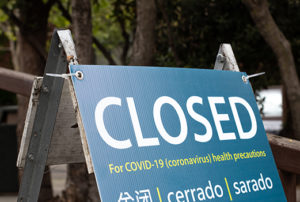COVID-19 & Crime Issue #2: Los Angeles Crime & The Routine Activities Theory
In issue #2 of our COVID-19 & Crime series, we examined retail crime reported in the Los Angeles area and highlight several preliminary trends for your consideration. Dr. Read Hayes, Research Scientist at the University of Florida, and Director of the Loss Prevention Research Council (LPRC), shared with us insights about what he is seeing in the retail world and perspectives on what might be in store in the upcoming weeks and months. Many thanks to Dr. Hayes for his contribution to this piece.
Download a PDF of this article
LOS ANGELES CRIME
Los Angeles, with hundreds of COVID-19 cases reported daily, is one of the cities hardest hit by the pandemic, and local residents have been living with increasingly stringent restrictions since the middle of March. CAP Index’s Analytics team examined crime reported to the Los Angeles Police Department (LAPD), focusing on weekly percentage changes in select crimes at retail establishments throughout the month. We also provide citywide trends for comparison. In some cases, we were able to narrow the numbers down to specific businesses that were able to continue their operations – like grocery or convenience stores – and reference those findings in the conclusions below.

Here are the key findings from our analysis:
- Total retail crime dropped somewhat in Week 2, flattened out in Week 3, and dropped some more in Week 4. The citywide crime trends follow almost the opposite pattern. It is most informative to drill down to the individual crime types to elucidate these weekly shifts.
- Although it involves low offense counts, retail aggravated assault shows an upward trend in Week 3 and 4, following a significant decrease in Week 2. Simple assault is subject to an opposite trend and is down after an initial spike in Week 2.
- Retail burglary shows a strong upward trend, while citywide burglary trends downward. COVID-19 & CRIME: Los Angeles Crime for March 2020.
- Both retail and citywide robbery spiked in Week 3. Most of this increase occurred at locations that continued to operate, like grocery and convenience stores.
- Shoplifting dropped consistently from week to week, with grand theft declining more significantly. However, a significant portion of this could be a function of store closures. Based upon our assessment of businesses that continued to operate, petty theft was up 7% for Week 2, 10% for Week 3, and 6% for Week 4.
- Vandalism trended upward, especially for retail in Week 4.
INTERPRETING THE FINDINGS – ROUTINE ACTIVITIES THEORY
Criminology’s well-accepted Routine Activities Theory provides a good context for interpreting these findings. It assumes that crime is likely to occur when three essential elements converge in time and space: a likely offender, a suitable target, and the absence of capable guardianship.
A LIKELY OFFENDER
With sheltering in place, one would expect there to be significantly fewer people on the streets, including criminals. However, we continue to see reports of violent crime interspersed among the COVID-19 headlines. Twenty people were shot in the Chicago streets the weekend starting March 27th despite a sheltering in place order. Are some offenders not afraid of the pandemic?
According to Dr. Hayes, while some may have been intimidated initially, the fear may be disappearing quickly, with some criminals taking advantage of limited guardianship.
Furthermore, some perpetrators may have heightened motivation to commit crimes as they lose their sources of income. The need to provide for oneself or one’s family may, in fact, create new offenders – those with no criminal history who are now operating in a survival mode. For example, Dr. Hayes points out that there have been reports of Instacart personnel stealing groceries from customers. There are also anecdotal reports of increases in internal theft. Considering this, the increase in shoplifting for Los Angeles businesses continuing to operate is not at all surprising. The same economic motive might apply to the spike in robbery seen in March. Surges in gun sales raise questions about the potential for violence in the future.
A SUITABLE TARGET
With many retailers closing or modifying hours, there are fewer venues for traditional retail crimes such as shoplifting or check fraud. However, retailers who continue store COVID-19 Sign for Closed Store operations may end up becoming victims of crime displacement from other retail segments, as seen in increases in shoplifting or robberies in LA. In some respects, closed locations have heightened exposures for some crimes like burglary. As Dr. Hayes points out, there are many stores that have nobody guarding them and may not have the proper technology to protect them from break-ins. That may explain why some retailers are boarding up their closed locations.
GUARDIANSHIP
Dr. Hayes strongly emphasizes the importance of guardianship, or the lack of it, in the COVID-19 era. Retailers that continue to operate face loss prevention resource challenges, with higher than normal absentee rates, and shifting priorities to COVID-19 related duties. Reduced customer traffic in stores removes the benefit of natural surveillance that is provided by other shoppers. Finally, law enforcement resources are limited due to officers being out sick, changes in response protocols, and resources shifted to enforcing quarantines. The negative impact of these factors is likely to continue to increase, and the LA analysis suggests that criminals may be taking advantage of reduced guardianship. The LAPD expressed concern about the increase in business break-ins and committed to patrolling retail location, but with police resources strained, how effective will they be?
 FINAL THOUGHTS
FINAL THOUGHTS
Given the principles of Routine Activity Theory, increases in likely offenders, plenty of suitable targets, and decreases in guardianship could set the environment for major crime increases. Even without the pandemic, retail security professionals’ jobs are difficult, as criminals get more creative. With the new pressures arising from the COVID-19 pandemic, the job gets even harder. What should retailers be doing differently to face this challenge?
Dr. Hayes suggests it is important to stay vigilant and consider new protocols. For instance, with grocery stores reserving specific hours solely for shoppers over 60, we must consider not only how to keep these vulnerable customers from getting infected, but also from becoming victims of crime. Should retailers provide additional security during those times? What are the liability implications? What does the shift to increased delivery imply? What needs to be done to protect delivery personnel from both disease and robbery?
These are some of the many questions that we will explore in future issues. CAP’s team is here to help you monitor emerging trends and facilitate discussions among practitioners and industry experts to help mitigate evolving risks. We are especially interested in collecting and analyzing crime data directly from retailers. We suspect that a lot of incidents do not get reported to the police, which is why it is important to gather information directly from the source.
Article by: Basia Pietrawska, VP, Consulting & Analytics – Steven K. Aurand, President & CEO – Walter E. Palmer, Executive Vice President

 Sample CRIMECAST Reports
Sample CRIMECAST Reports